Unit 5: Management Accounting Report - Unilever Analysis
VerifiedAdded on 2022/12/30
|22
|5891
|91
Report
AI Summary
This report delves into the core concepts of management accounting (MA) and its practical applications within organizations, using Unilever as a case study. It outlines how MA is used to identify, measure, and analyze financial information for decision-making, covering both short-term and long-term strategies. The report explores various MA techniques, including product costing, cash flow analysis, constraint analysis, accounts receivable management, trend analysis and forecasting, and inventory turnover analysis. Furthermore, it examines different reporting methods like budgeting, performance analysis, job costing, capital budgeting, inventory and manufacturing reports, pro forma cash flow, sales reports, and item cost reports, along with an explanation of marginal and absorption costing. The report highlights how MA supports financial planning, operational efficiency, and strategic investment decisions, providing a comprehensive understanding of its role in business management.
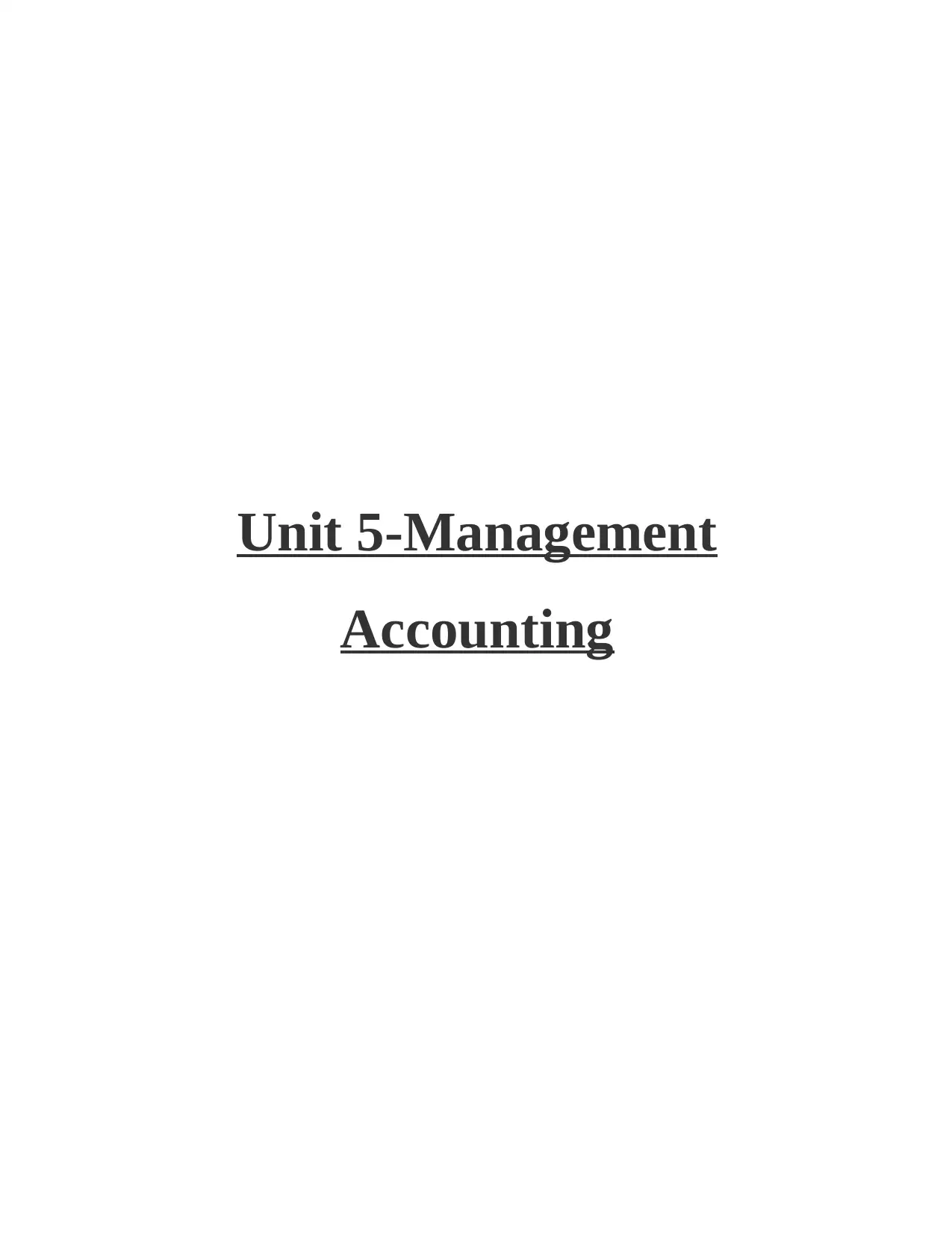
Unit 5-Management
Accounting
Accounting
Paraphrase This Document
Need a fresh take? Get an instant paraphrase of this document with our AI Paraphraser
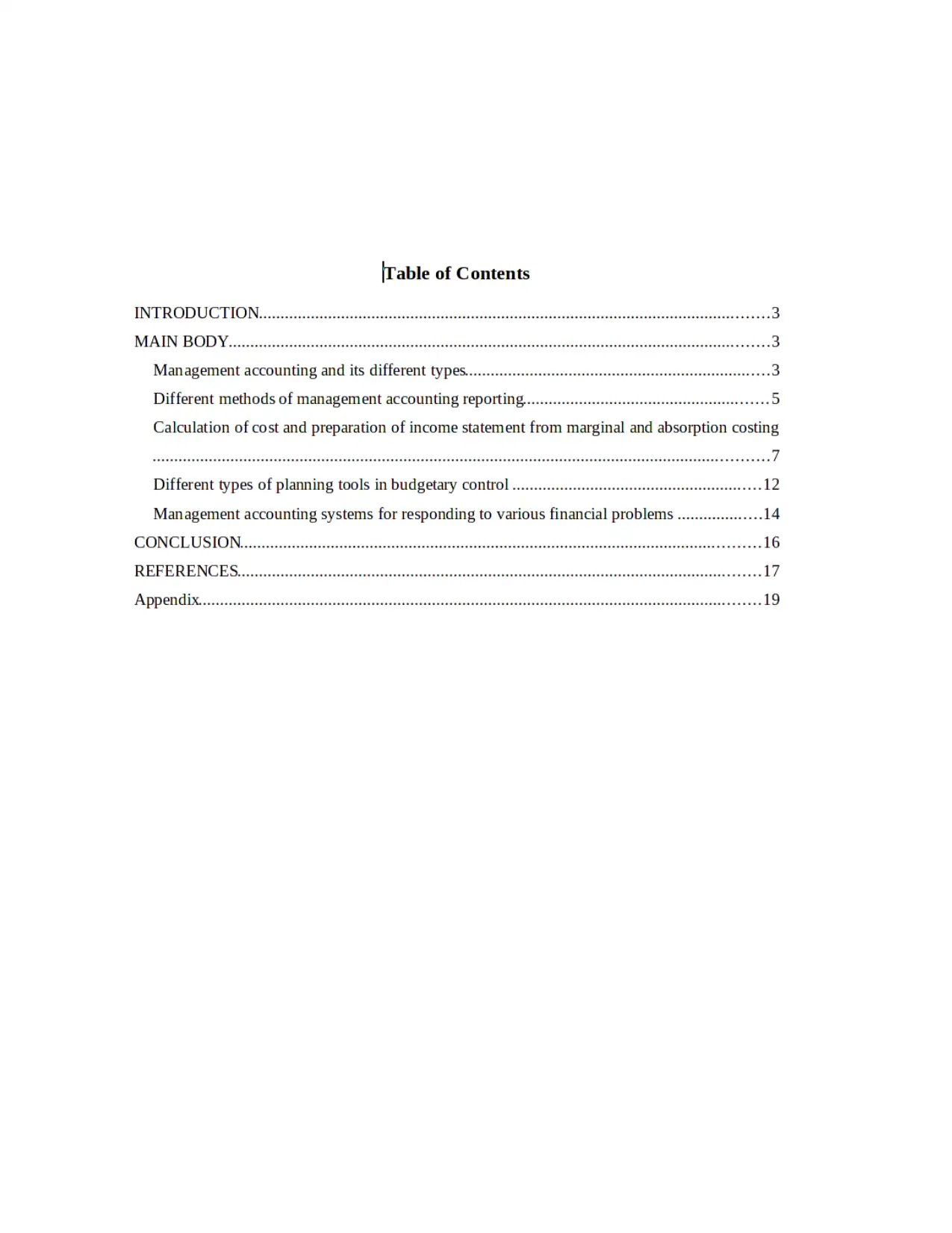

⊘ This is a preview!⊘
Do you want full access?
Subscribe today to unlock all pages.

Trusted by 1+ million students worldwide
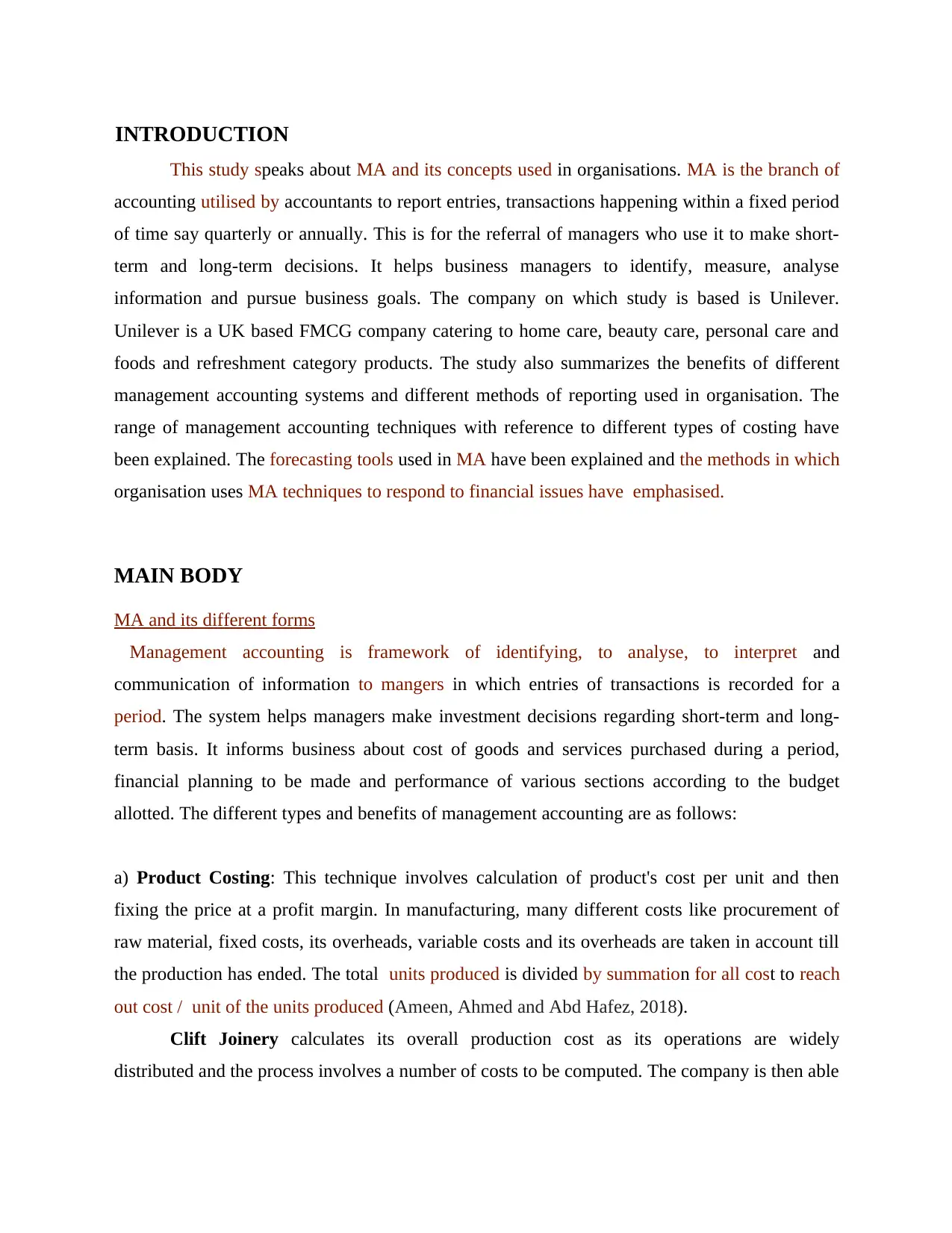
INTRODUCTION
This study speaks about MA and its concepts used in organisations. MA is the branch of
accounting utilised by accountants to report entries, transactions happening within a fixed period
of time say quarterly or annually. This is for the referral of managers who use it to make short-
term and long-term decisions. It helps business managers to identify, measure, analyse
information and pursue business goals. The company on which study is based is Unilever.
Unilever is a UK based FMCG company catering to home care, beauty care, personal care and
foods and refreshment category products. The study also summarizes the benefits of different
management accounting systems and different methods of reporting used in organisation. The
range of management accounting techniques with reference to different types of costing have
been explained. The forecasting tools used in MA have been explained and the methods in which
organisation uses MA techniques to respond to financial issues have emphasised.
MAIN BODY
MA and its different forms
Management accounting is framework of identifying, to analyse, to interpret and
communication of information to mangers in which entries of transactions is recorded for a
period. The system helps managers make investment decisions regarding short-term and long-
term basis. It informs business about cost of goods and services purchased during a period,
financial planning to be made and performance of various sections according to the budget
allotted. The different types and benefits of management accounting are as follows:
a) Product Costing: This technique involves calculation of product's cost per unit and then
fixing the price at a profit margin. In manufacturing, many different costs like procurement of
raw material, fixed costs, its overheads, variable costs and its overheads are taken in account till
the production has ended. The total units produced is divided by summation for all cost to reach
out cost / unit of the units produced (Ameen, Ahmed and Abd Hafez, 2018).
Clift Joinery calculates its overall production cost as its operations are widely
distributed and the process involves a number of costs to be computed. The company is then able
This study speaks about MA and its concepts used in organisations. MA is the branch of
accounting utilised by accountants to report entries, transactions happening within a fixed period
of time say quarterly or annually. This is for the referral of managers who use it to make short-
term and long-term decisions. It helps business managers to identify, measure, analyse
information and pursue business goals. The company on which study is based is Unilever.
Unilever is a UK based FMCG company catering to home care, beauty care, personal care and
foods and refreshment category products. The study also summarizes the benefits of different
management accounting systems and different methods of reporting used in organisation. The
range of management accounting techniques with reference to different types of costing have
been explained. The forecasting tools used in MA have been explained and the methods in which
organisation uses MA techniques to respond to financial issues have emphasised.
MAIN BODY
MA and its different forms
Management accounting is framework of identifying, to analyse, to interpret and
communication of information to mangers in which entries of transactions is recorded for a
period. The system helps managers make investment decisions regarding short-term and long-
term basis. It informs business about cost of goods and services purchased during a period,
financial planning to be made and performance of various sections according to the budget
allotted. The different types and benefits of management accounting are as follows:
a) Product Costing: This technique involves calculation of product's cost per unit and then
fixing the price at a profit margin. In manufacturing, many different costs like procurement of
raw material, fixed costs, its overheads, variable costs and its overheads are taken in account till
the production has ended. The total units produced is divided by summation for all cost to reach
out cost / unit of the units produced (Ameen, Ahmed and Abd Hafez, 2018).
Clift Joinery calculates its overall production cost as its operations are widely
distributed and the process involves a number of costs to be computed. The company is then able
Paraphrase This Document
Need a fresh take? Get an instant paraphrase of this document with our AI Paraphraser

to ascertain the price of products by setting a profit margin which is in consideration with market
prices.
This technique thus helps in accurate determining of the products and cost computing.
b) Cash flow analysis: Business decisions and their implementation involve cash inflow and
outflow on investment in a project. The manager will require the information of the financial
impact of the transactions taking place. For e.g. company planning to buy an equipment can do it
either by purchasing through company capital or by using debt in form of a bank loan. The
outcomes in form of cash flows regarding purchase using both options will be weighed and the
more profitable investment will be given nod (Abdusalomova, 2019).
Clift joinery uses the method to make investments while diversifying wooden products
as to the costs involved and the optimization of cash flow to be achieved and maintain the
working capital.
c) Constraint Analysis: Management accounting here helps in identifying the constraints which
may be coming in production or sales process. This helps in identifying the bottlenecks which
may be occurring in the process and the impact they are having on revenue and cash flow.
Managers thus think of suitable measures to help in eradication of bottlenecks and improve
efficiencies in the process (Ameen, Ahmed and Abd Hafez, 2018).
Clift Joinery uses constraint analysis to overcome constraints in production process. For
e.g. company taking key widgets in production from only one supplier who may be operating at
its full operational capacity can be a bottleneck as it may happen due to circumstances supplier is
not able to reach company's increasing order. Hence, management will have to increase suppliers
in this group and consider its additional cost for future returns.
d) Accounts Receivable Management: The company categorizes its account receivables i.e.
money pending from its debtors according to time length such as 30 days, 30+ days, more than
60 days etc. Management accounting categorises these by the period of time they are
outstanding. The faster the company is able to receive the credit, the better it is for the
company's working capital. It can also help in realising whether the company requires to do a
change in credit policy if there are many defaulters.
prices.
This technique thus helps in accurate determining of the products and cost computing.
b) Cash flow analysis: Business decisions and their implementation involve cash inflow and
outflow on investment in a project. The manager will require the information of the financial
impact of the transactions taking place. For e.g. company planning to buy an equipment can do it
either by purchasing through company capital or by using debt in form of a bank loan. The
outcomes in form of cash flows regarding purchase using both options will be weighed and the
more profitable investment will be given nod (Abdusalomova, 2019).
Clift joinery uses the method to make investments while diversifying wooden products
as to the costs involved and the optimization of cash flow to be achieved and maintain the
working capital.
c) Constraint Analysis: Management accounting here helps in identifying the constraints which
may be coming in production or sales process. This helps in identifying the bottlenecks which
may be occurring in the process and the impact they are having on revenue and cash flow.
Managers thus think of suitable measures to help in eradication of bottlenecks and improve
efficiencies in the process (Ameen, Ahmed and Abd Hafez, 2018).
Clift Joinery uses constraint analysis to overcome constraints in production process. For
e.g. company taking key widgets in production from only one supplier who may be operating at
its full operational capacity can be a bottleneck as it may happen due to circumstances supplier is
not able to reach company's increasing order. Hence, management will have to increase suppliers
in this group and consider its additional cost for future returns.
d) Accounts Receivable Management: The company categorizes its account receivables i.e.
money pending from its debtors according to time length such as 30 days, 30+ days, more than
60 days etc. Management accounting categorises these by the period of time they are
outstanding. The faster the company is able to receive the credit, the better it is for the
company's working capital. It can also help in realising whether the company requires to do a
change in credit policy if there are many defaulters.
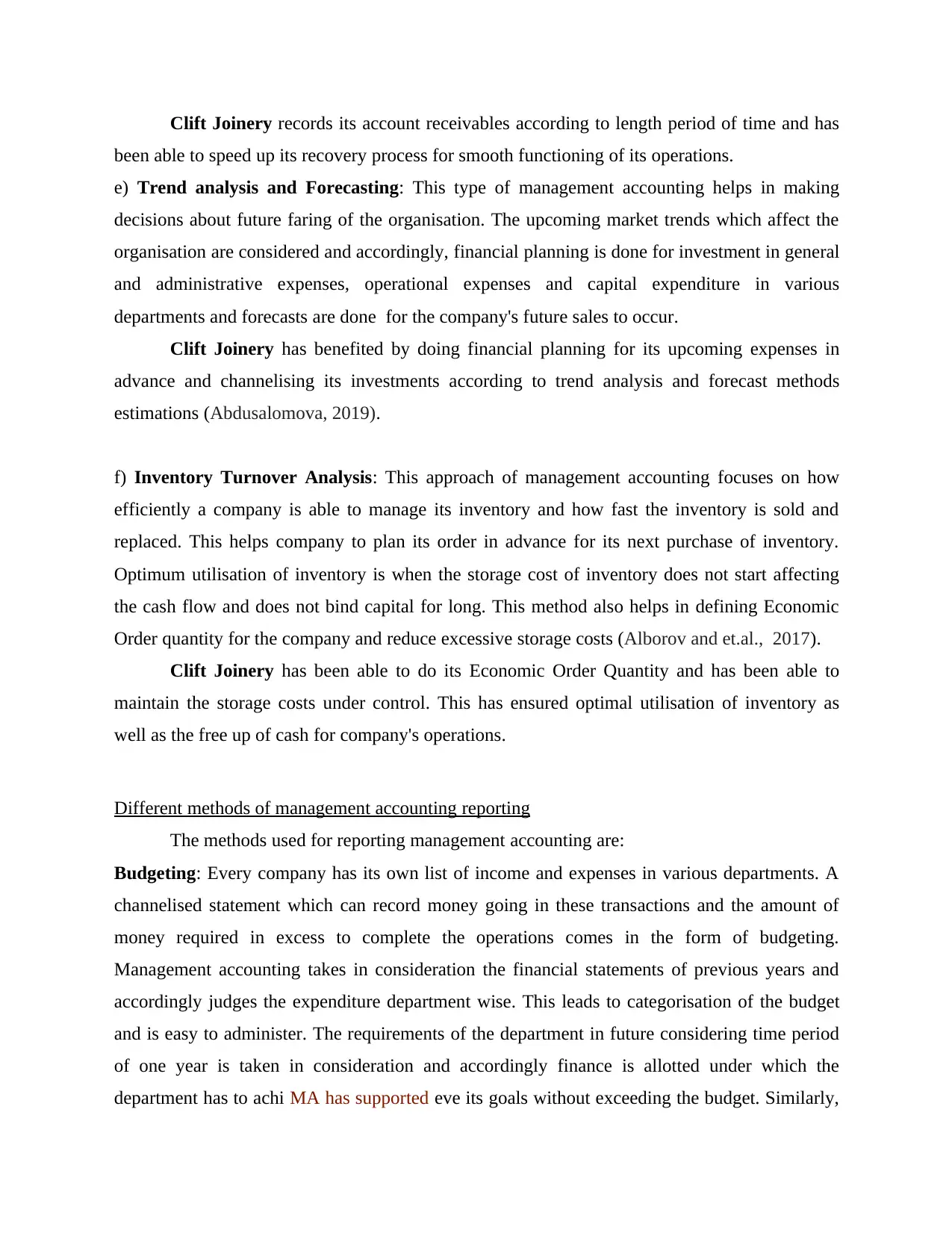
Clift Joinery records its account receivables according to length period of time and has
been able to speed up its recovery process for smooth functioning of its operations.
e) Trend analysis and Forecasting: This type of management accounting helps in making
decisions about future faring of the organisation. The upcoming market trends which affect the
organisation are considered and accordingly, financial planning is done for investment in general
and administrative expenses, operational expenses and capital expenditure in various
departments and forecasts are done for the company's future sales to occur.
Clift Joinery has benefited by doing financial planning for its upcoming expenses in
advance and channelising its investments according to trend analysis and forecast methods
estimations (Abdusalomova, 2019).
f) Inventory Turnover Analysis: This approach of management accounting focuses on how
efficiently a company is able to manage its inventory and how fast the inventory is sold and
replaced. This helps company to plan its order in advance for its next purchase of inventory.
Optimum utilisation of inventory is when the storage cost of inventory does not start affecting
the cash flow and does not bind capital for long. This method also helps in defining Economic
Order quantity for the company and reduce excessive storage costs (Alborov and et.al., 2017).
Clift Joinery has been able to do its Economic Order Quantity and has been able to
maintain the storage costs under control. This has ensured optimal utilisation of inventory as
well as the free up of cash for company's operations.
Different methods of management accounting reporting
The methods used for reporting management accounting are:
Budgeting: Every company has its own list of income and expenses in various departments. A
channelised statement which can record money going in these transactions and the amount of
money required in excess to complete the operations comes in the form of budgeting.
Management accounting takes in consideration the financial statements of previous years and
accordingly judges the expenditure department wise. This leads to categorisation of the budget
and is easy to administer. The requirements of the department in future considering time period
of one year is taken in consideration and accordingly finance is allotted under which the
department has to achi MA has supported eve its goals without exceeding the budget. Similarly,
been able to speed up its recovery process for smooth functioning of its operations.
e) Trend analysis and Forecasting: This type of management accounting helps in making
decisions about future faring of the organisation. The upcoming market trends which affect the
organisation are considered and accordingly, financial planning is done for investment in general
and administrative expenses, operational expenses and capital expenditure in various
departments and forecasts are done for the company's future sales to occur.
Clift Joinery has benefited by doing financial planning for its upcoming expenses in
advance and channelising its investments according to trend analysis and forecast methods
estimations (Abdusalomova, 2019).
f) Inventory Turnover Analysis: This approach of management accounting focuses on how
efficiently a company is able to manage its inventory and how fast the inventory is sold and
replaced. This helps company to plan its order in advance for its next purchase of inventory.
Optimum utilisation of inventory is when the storage cost of inventory does not start affecting
the cash flow and does not bind capital for long. This method also helps in defining Economic
Order quantity for the company and reduce excessive storage costs (Alborov and et.al., 2017).
Clift Joinery has been able to do its Economic Order Quantity and has been able to
maintain the storage costs under control. This has ensured optimal utilisation of inventory as
well as the free up of cash for company's operations.
Different methods of management accounting reporting
The methods used for reporting management accounting are:
Budgeting: Every company has its own list of income and expenses in various departments. A
channelised statement which can record money going in these transactions and the amount of
money required in excess to complete the operations comes in the form of budgeting.
Management accounting takes in consideration the financial statements of previous years and
accordingly judges the expenditure department wise. This leads to categorisation of the budget
and is easy to administer. The requirements of the department in future considering time period
of one year is taken in consideration and accordingly finance is allotted under which the
department has to achi MA has supported eve its goals without exceeding the budget. Similarly,
⊘ This is a preview!⊘
Do you want full access?
Subscribe today to unlock all pages.

Trusted by 1+ million students worldwide
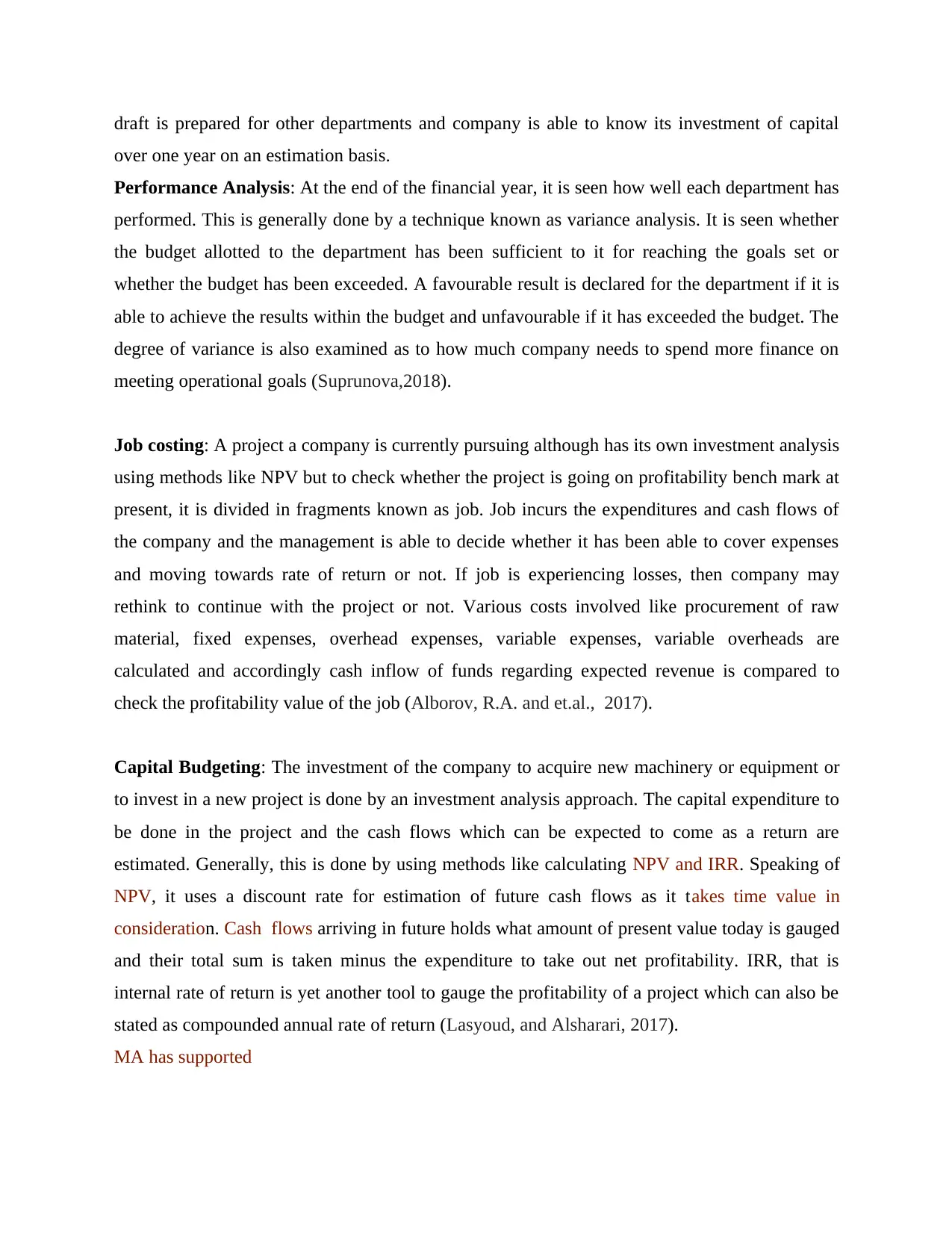
draft is prepared for other departments and company is able to know its investment of capital
over one year on an estimation basis.
Performance Analysis: At the end of the financial year, it is seen how well each department has
performed. This is generally done by a technique known as variance analysis. It is seen whether
the budget allotted to the department has been sufficient to it for reaching the goals set or
whether the budget has been exceeded. A favourable result is declared for the department if it is
able to achieve the results within the budget and unfavourable if it has exceeded the budget. The
degree of variance is also examined as to how much company needs to spend more finance on
meeting operational goals (Suprunova,2018).
Job costing: A project a company is currently pursuing although has its own investment analysis
using methods like NPV but to check whether the project is going on profitability bench mark at
present, it is divided in fragments known as job. Job incurs the expenditures and cash flows of
the company and the management is able to decide whether it has been able to cover expenses
and moving towards rate of return or not. If job is experiencing losses, then company may
rethink to continue with the project or not. Various costs involved like procurement of raw
material, fixed expenses, overhead expenses, variable expenses, variable overheads are
calculated and accordingly cash inflow of funds regarding expected revenue is compared to
check the profitability value of the job (Alborov, R.A. and et.al., 2017).
Capital Budgeting: The investment of the company to acquire new machinery or equipment or
to invest in a new project is done by an investment analysis approach. The capital expenditure to
be done in the project and the cash flows which can be expected to come as a return are
estimated. Generally, this is done by using methods like calculating NPV and IRR. Speaking of
NPV, it uses a discount rate for estimation of future cash flows as it takes time value in
consideration. Cash flows arriving in future holds what amount of present value today is gauged
and their total sum is taken minus the expenditure to take out net profitability. IRR, that is
internal rate of return is yet another tool to gauge the profitability of a project which can also be
stated as compounded annual rate of return (Lasyoud, and Alsharari, 2017).
MA has supported
over one year on an estimation basis.
Performance Analysis: At the end of the financial year, it is seen how well each department has
performed. This is generally done by a technique known as variance analysis. It is seen whether
the budget allotted to the department has been sufficient to it for reaching the goals set or
whether the budget has been exceeded. A favourable result is declared for the department if it is
able to achieve the results within the budget and unfavourable if it has exceeded the budget. The
degree of variance is also examined as to how much company needs to spend more finance on
meeting operational goals (Suprunova,2018).
Job costing: A project a company is currently pursuing although has its own investment analysis
using methods like NPV but to check whether the project is going on profitability bench mark at
present, it is divided in fragments known as job. Job incurs the expenditures and cash flows of
the company and the management is able to decide whether it has been able to cover expenses
and moving towards rate of return or not. If job is experiencing losses, then company may
rethink to continue with the project or not. Various costs involved like procurement of raw
material, fixed expenses, overhead expenses, variable expenses, variable overheads are
calculated and accordingly cash inflow of funds regarding expected revenue is compared to
check the profitability value of the job (Alborov, R.A. and et.al., 2017).
Capital Budgeting: The investment of the company to acquire new machinery or equipment or
to invest in a new project is done by an investment analysis approach. The capital expenditure to
be done in the project and the cash flows which can be expected to come as a return are
estimated. Generally, this is done by using methods like calculating NPV and IRR. Speaking of
NPV, it uses a discount rate for estimation of future cash flows as it takes time value in
consideration. Cash flows arriving in future holds what amount of present value today is gauged
and their total sum is taken minus the expenditure to take out net profitability. IRR, that is
internal rate of return is yet another tool to gauge the profitability of a project which can also be
stated as compounded annual rate of return (Lasyoud, and Alsharari, 2017).
MA has supported
Paraphrase This Document
Need a fresh take? Get an instant paraphrase of this document with our AI Paraphraser

Inventory and manufacturing reports: The inventory costs comprising of storage and
handling inventory, labour cost, overhead costs and wastages which can occur due to damaged
inventory apart from other administrative expenses are all prepared in a report. Also costs
involving direct and indirect expenses in manufacturing are all summarized in form of a report.
This helps to check how much extra expenditure is there and where the company needs to take
measures to reduce operational expenses.
Pro forma cash flow: The money projected to come in short term and medium term accounting
periods and expenditure forecasted is reflected in pro forma cash flow. It shows month by month
summary of cash inflow and outflow, and gives an indication to company when to expect
shortages and when to expect surpluses. As it is usually done on a short-term basis, the chance of
inaccuracies are less (Suprunova, 2018).
Sales Reports: These reports depict the company's performance in its diversified product
range and the method of selling which is more profitable. This lays light on the sources which
are generating higher revenues for the company and which sections need to be improved. The
report also helps in realising which employees are performing well up to the expectations and
which employees need to be motiv This ated to perform better.
Item cost reports: This method reflects the category wise distribution of expenses
involving each type of product. The costs involved such as labour, materials and expenses such
as licenses etc. are shown category wise. Also the sales achieved in that product category is also
calculated. Then the expenditure is reduced from the sales to calculate profit achieved from
category. This break down of costs will help company to realise its operational expenses and
where they can be reduced. Also, it will be able to know the category of products which are
under-performing and need a boost. It can also add on new features to the range of products
which are doing well (Lasyoud and Alsharari, 2017).
Calculation of cost and preparation of income statement from marginal and absorption costing
Meaning of cost: Cost refers to the amount of cash which is spend for getting something
in return. In every business cost is the main matter to be concerned because it must be always as
minimum as possible in order to maximise profits. Companies incur various costs for the
purpose of accomplishment of the end goals. Costs of the any company may include production
handling inventory, labour cost, overhead costs and wastages which can occur due to damaged
inventory apart from other administrative expenses are all prepared in a report. Also costs
involving direct and indirect expenses in manufacturing are all summarized in form of a report.
This helps to check how much extra expenditure is there and where the company needs to take
measures to reduce operational expenses.
Pro forma cash flow: The money projected to come in short term and medium term accounting
periods and expenditure forecasted is reflected in pro forma cash flow. It shows month by month
summary of cash inflow and outflow, and gives an indication to company when to expect
shortages and when to expect surpluses. As it is usually done on a short-term basis, the chance of
inaccuracies are less (Suprunova, 2018).
Sales Reports: These reports depict the company's performance in its diversified product
range and the method of selling which is more profitable. This lays light on the sources which
are generating higher revenues for the company and which sections need to be improved. The
report also helps in realising which employees are performing well up to the expectations and
which employees need to be motiv This ated to perform better.
Item cost reports: This method reflects the category wise distribution of expenses
involving each type of product. The costs involved such as labour, materials and expenses such
as licenses etc. are shown category wise. Also the sales achieved in that product category is also
calculated. Then the expenditure is reduced from the sales to calculate profit achieved from
category. This break down of costs will help company to realise its operational expenses and
where they can be reduced. Also, it will be able to know the category of products which are
under-performing and need a boost. It can also add on new features to the range of products
which are doing well (Lasyoud and Alsharari, 2017).
Calculation of cost and preparation of income statement from marginal and absorption costing
Meaning of cost: Cost refers to the amount of cash which is spend for getting something
in return. In every business cost is the main matter to be concerned because it must be always as
minimum as possible in order to maximise profits. Companies incur various costs for the
purpose of accomplishment of the end goals. Costs of the any company may include production
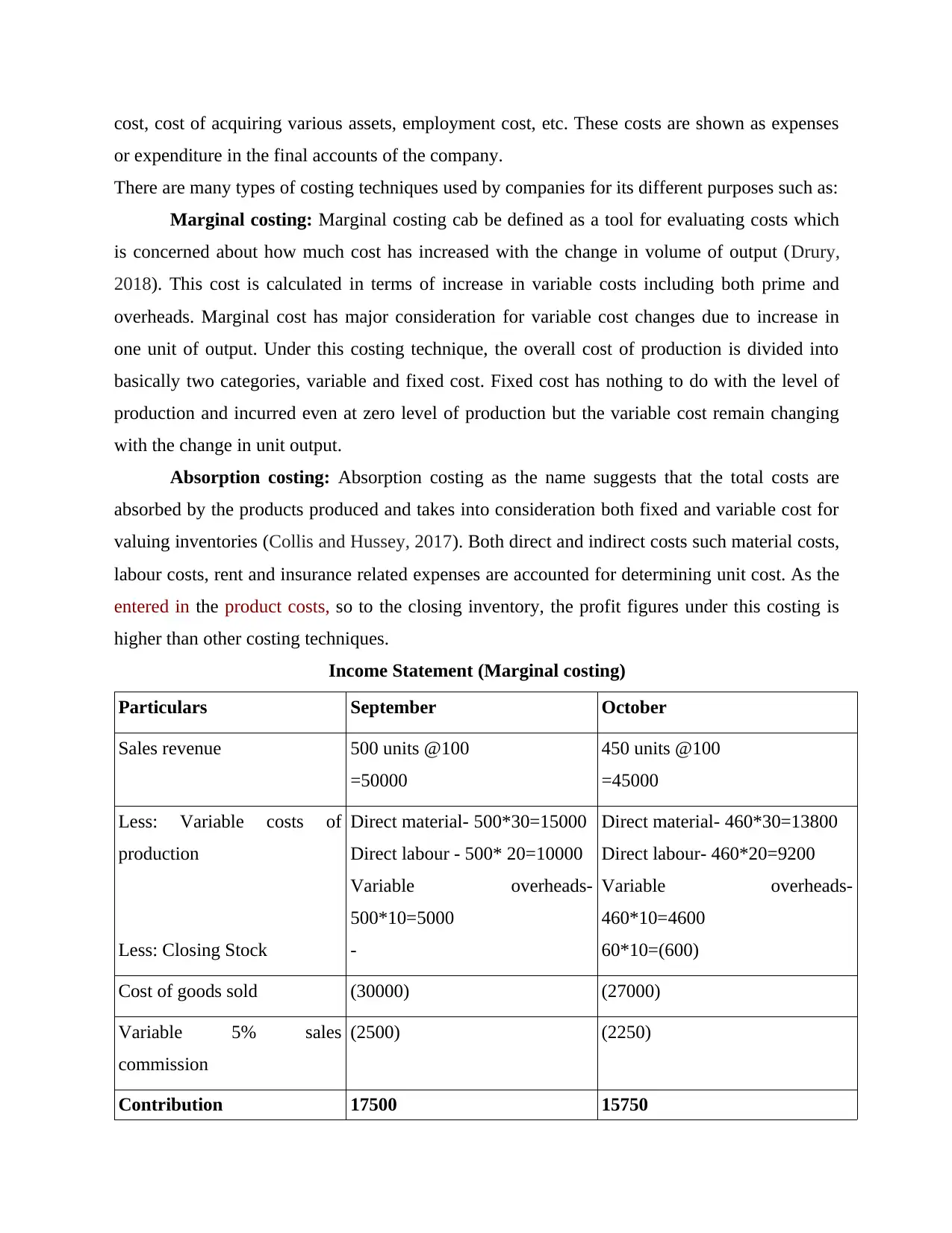
cost, cost of acquiring various assets, employment cost, etc. These costs are shown as expenses
or expenditure in the final accounts of the company.
There are many types of costing techniques used by companies for its different purposes such as:
Marginal costing: Marginal costing cab be defined as a tool for evaluating costs which
is concerned about how much cost has increased with the change in volume of output (Drury,
2018). This cost is calculated in terms of increase in variable costs including both prime and
overheads. Marginal cost has major consideration for variable cost changes due to increase in
one unit of output. Under this costing technique, the overall cost of production is divided into
basically two categories, variable and fixed cost. Fixed cost has nothing to do with the level of
production and incurred even at zero level of production but the variable cost remain changing
with the change in unit output.
Absorption costing: Absorption costing as the name suggests that the total costs are
absorbed by the products produced and takes into consideration both fixed and variable cost for
valuing inventories (Collis and Hussey, 2017). Both direct and indirect costs such material costs,
labour costs, rent and insurance related expenses are accounted for determining unit cost. As the
entered in the product costs, so to the closing inventory, the profit figures under this costing is
higher than other costing techniques.
Income Statement (Marginal costing)
Particulars September October
Sales revenue 500 units @100
=50000
450 units @100
=45000
Less: Variable costs of
production
Less: Closing Stock
Direct material- 500*30=15000
Direct labour - 500* 20=10000
Variable overheads-
500*10=5000
-
Direct material- 460*30=13800
Direct labour- 460*20=9200
Variable overheads-
460*10=4600
60*10=(600)
Cost of goods sold (30000) (27000)
Variable 5% sales
commission
(2500) (2250)
Contribution 17500 15750
or expenditure in the final accounts of the company.
There are many types of costing techniques used by companies for its different purposes such as:
Marginal costing: Marginal costing cab be defined as a tool for evaluating costs which
is concerned about how much cost has increased with the change in volume of output (Drury,
2018). This cost is calculated in terms of increase in variable costs including both prime and
overheads. Marginal cost has major consideration for variable cost changes due to increase in
one unit of output. Under this costing technique, the overall cost of production is divided into
basically two categories, variable and fixed cost. Fixed cost has nothing to do with the level of
production and incurred even at zero level of production but the variable cost remain changing
with the change in unit output.
Absorption costing: Absorption costing as the name suggests that the total costs are
absorbed by the products produced and takes into consideration both fixed and variable cost for
valuing inventories (Collis and Hussey, 2017). Both direct and indirect costs such material costs,
labour costs, rent and insurance related expenses are accounted for determining unit cost. As the
entered in the product costs, so to the closing inventory, the profit figures under this costing is
higher than other costing techniques.
Income Statement (Marginal costing)
Particulars September October
Sales revenue 500 units @100
=50000
450 units @100
=45000
Less: Variable costs of
production
Less: Closing Stock
Direct material- 500*30=15000
Direct labour - 500* 20=10000
Variable overheads-
500*10=5000
-
Direct material- 460*30=13800
Direct labour- 460*20=9200
Variable overheads-
460*10=4600
60*10=(600)
Cost of goods sold (30000) (27000)
Variable 5% sales
commission
(2500) (2250)
Contribution 17500 15750
⊘ This is a preview!⊘
Do you want full access?
Subscribe today to unlock all pages.

Trusted by 1+ million students worldwide
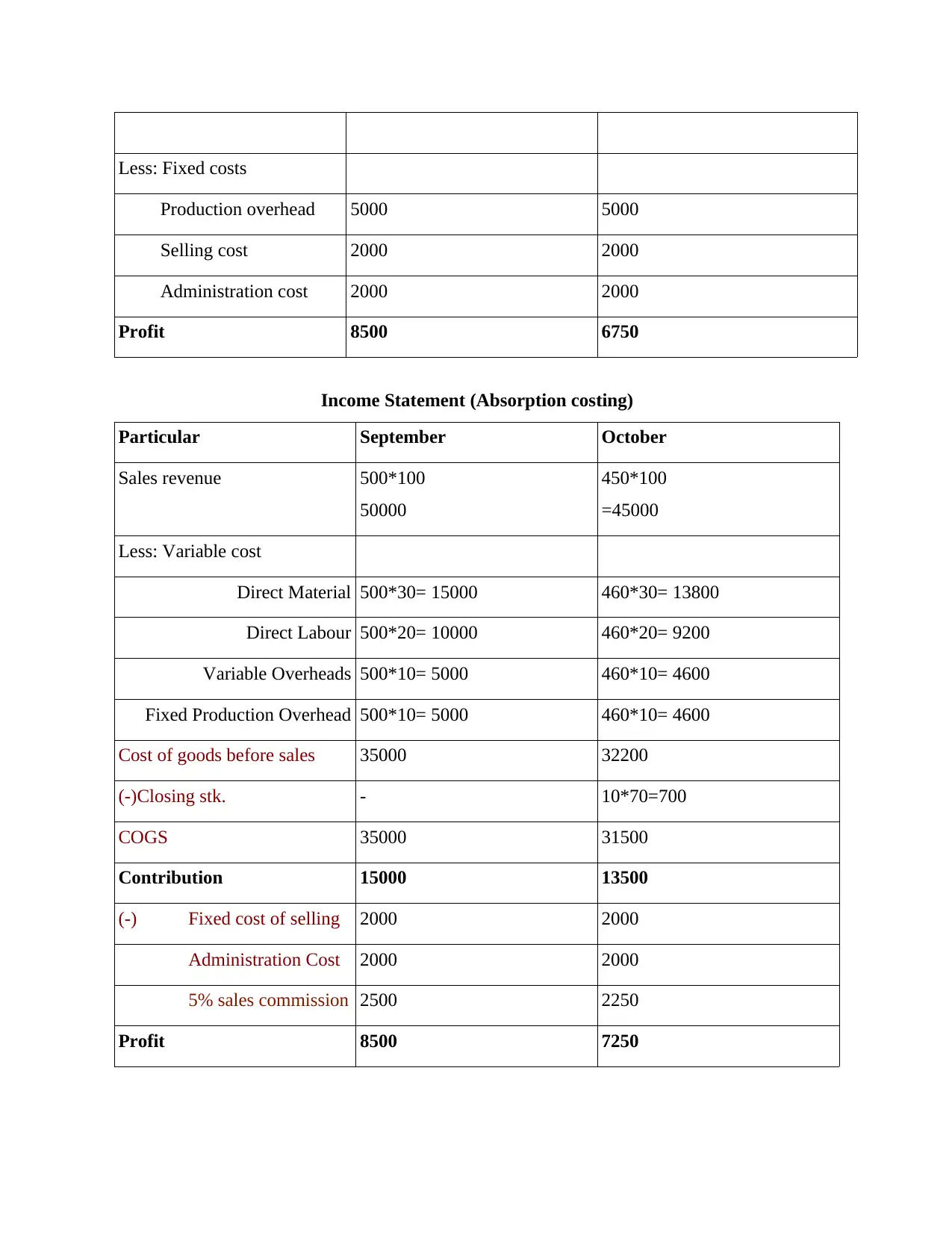
Less: Fixed costs
Production overhead 5000 5000
Selling cost 2000 2000
Administration cost 2000 2000
Profit 8500 6750
Income Statement (Absorption costing)
Particular September October
Sales revenue 500*100
50000
450*100
=45000
Less: Variable cost
Direct Material 500*30= 15000 460*30= 13800
Direct Labour 500*20= 10000 460*20= 9200
Variable Overheads 500*10= 5000 460*10= 4600
Fixed Production Overhead 500*10= 5000 460*10= 4600
Cost of goods before sales 35000 32200
(-)Closing stk. - 10*70=700
COGS 35000 31500
Contribution 15000 13500
(-) Fixed cost of selling 2000 2000
Administration Cost 2000 2000
5% sales commission 2500 2250
Profit 8500 7250
Production overhead 5000 5000
Selling cost 2000 2000
Administration cost 2000 2000
Profit 8500 6750
Income Statement (Absorption costing)
Particular September October
Sales revenue 500*100
50000
450*100
=45000
Less: Variable cost
Direct Material 500*30= 15000 460*30= 13800
Direct Labour 500*20= 10000 460*20= 9200
Variable Overheads 500*10= 5000 460*10= 4600
Fixed Production Overhead 500*10= 5000 460*10= 4600
Cost of goods before sales 35000 32200
(-)Closing stk. - 10*70=700
COGS 35000 31500
Contribution 15000 13500
(-) Fixed cost of selling 2000 2000
Administration Cost 2000 2000
5% sales commission 2500 2250
Profit 8500 7250
Paraphrase This Document
Need a fresh take? Get an instant paraphrase of this document with our AI Paraphraser

Reconciled profit
Particulars September October
Profit through MC 8500 6750
(+): variation in output level* production overhead / unit - 40*10= 400
(+): Fixed production overhead cost included in closing stock - 10*10=100
Profit through AC 8500 7250
Material Variances (MV)
Standard
quantity(SQ)
Standard price
(SP)
Standard cost
(SC)
Actual
quantity (AQ)
Actual MA
has supported
price(AP)
Actual
Cost(AC)
5000 10 50000 5500 9 49500
MCV = SC – AC
SC AC 500(Favourable)
50000 49500
MPV = (SP – AP)*AQ
SP AP AQ 5500(favourable)
10 9 5500
MUV = (SQ – AQ)* SP
SQ AQ SP -5000(Adverse)
5000 5500 10
MMV = (RSQ – AQ)*SP
Revised standard qty. or RSQ=(AC) /(SP)
= 49500 / 10 = 4950
Particulars September October
Profit through MC 8500 6750
(+): variation in output level* production overhead / unit - 40*10= 400
(+): Fixed production overhead cost included in closing stock - 10*10=100
Profit through AC 8500 7250
Material Variances (MV)
Standard
quantity(SQ)
Standard price
(SP)
Standard cost
(SC)
Actual
quantity (AQ)
Actual MA
has supported
price(AP)
Actual
Cost(AC)
5000 10 50000 5500 9 49500
MCV = SC – AC
SC AC 500(Favourable)
50000 49500
MPV = (SP – AP)*AQ
SP AP AQ 5500(favourable)
10 9 5500
MUV = (SQ – AQ)* SP
SQ AQ SP -5000(Adverse)
5000 5500 10
MMV = (RSQ – AQ)*SP
Revised standard qty. or RSQ=(AC) /(SP)
= 49500 / 10 = 4950
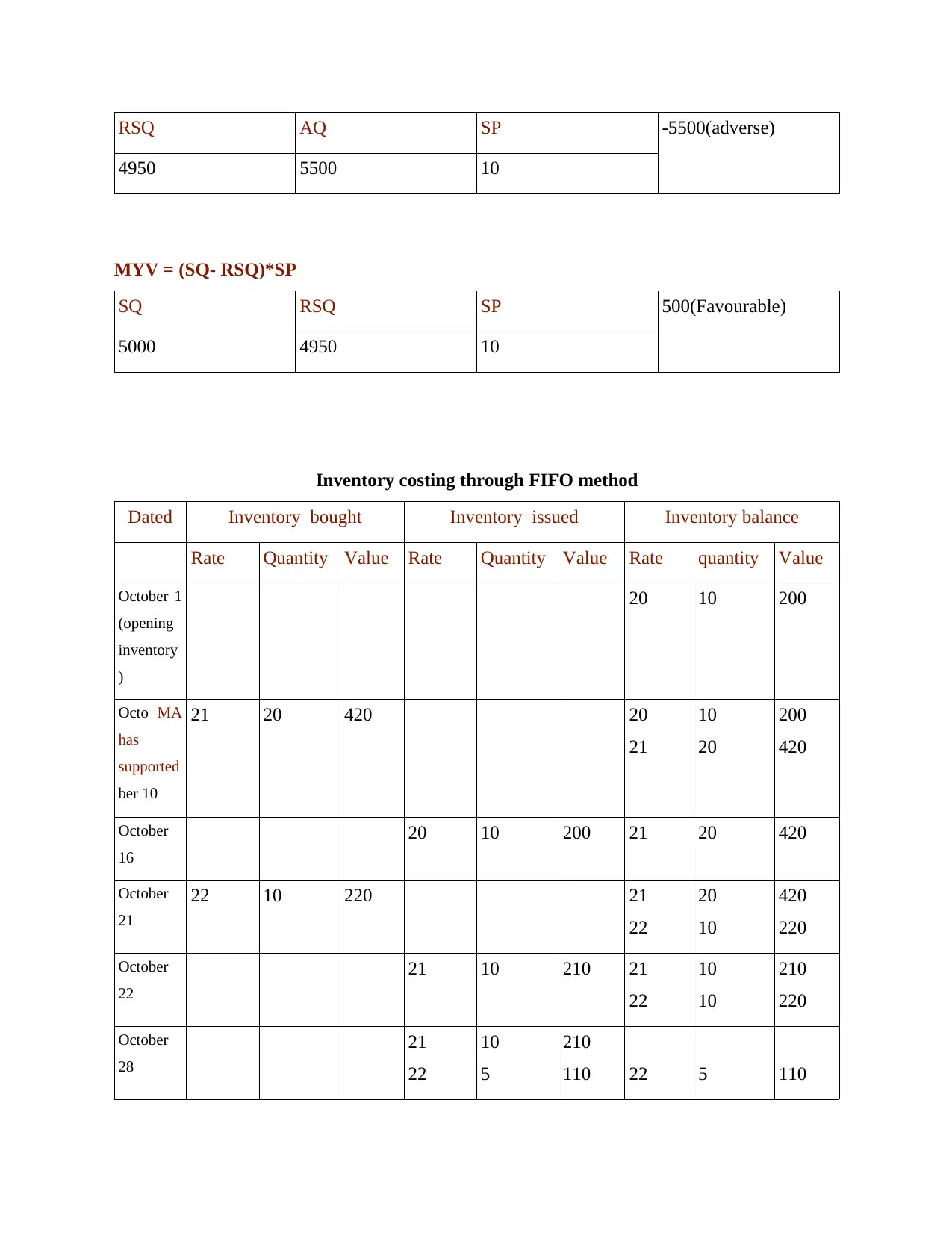
RSQ AQ SP -5500(adverse)
4950 5500 10
MYV = (SQ- RSQ)*SP
SQ RSQ SP 500(Favourable)
5000 4950 10
Inventory costing through FIFO method
Dated Inventory bought Inventory issued Inventory balance
Rate Quantity Value Rate Quantity Value Rate quantity Value
October 1
(opening
inventory
)
20 10 200
Octo MA
has
supported
ber 10
21 20 420 20
21
10
20
200
420
October
16
20 10 200 21 20 420
October
21
22 10 220 21
22
20
10
420
220
October
22
21 10 210 21
22
10
10
210
220
October
28
21
22
10
5
210
110 22 5 110
4950 5500 10
MYV = (SQ- RSQ)*SP
SQ RSQ SP 500(Favourable)
5000 4950 10
Inventory costing through FIFO method
Dated Inventory bought Inventory issued Inventory balance
Rate Quantity Value Rate Quantity Value Rate quantity Value
October 1
(opening
inventory
)
20 10 200
Octo MA
has
supported
ber 10
21 20 420 20
21
10
20
200
420
October
16
20 10 200 21 20 420
October
21
22 10 220 21
22
20
10
420
220
October
22
21 10 210 21
22
10
10
210
220
October
28
21
22
10
5
210
110 22 5 110
⊘ This is a preview!⊘
Do you want full access?
Subscribe today to unlock all pages.

Trusted by 1+ million students worldwide
1 out of 22
Related Documents
Your All-in-One AI-Powered Toolkit for Academic Success.
+13062052269
info@desklib.com
Available 24*7 on WhatsApp / Email
![[object Object]](/_next/static/media/star-bottom.7253800d.svg)
Unlock your academic potential
Copyright © 2020–2025 A2Z Services. All Rights Reserved. Developed and managed by ZUCOL.




